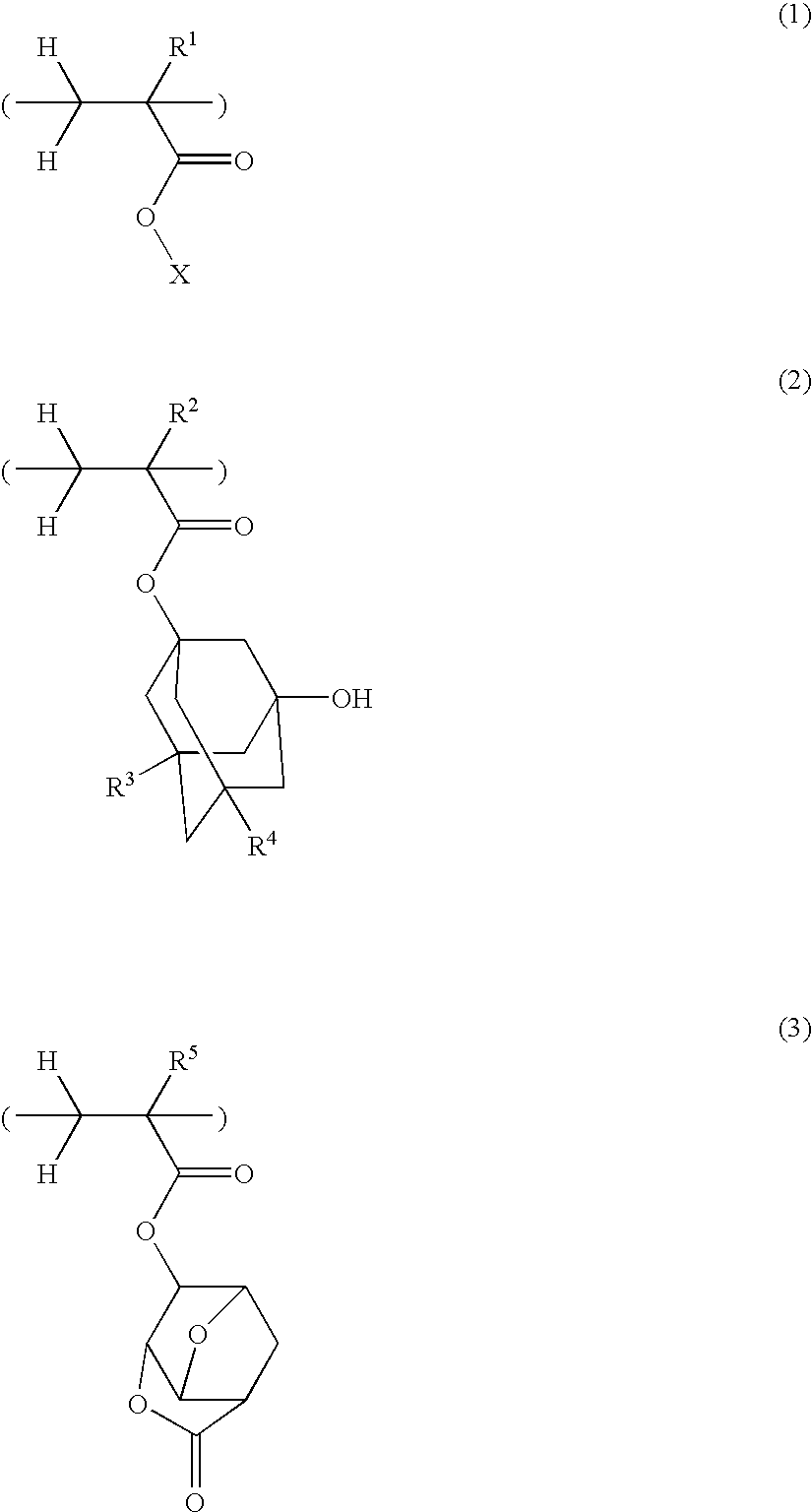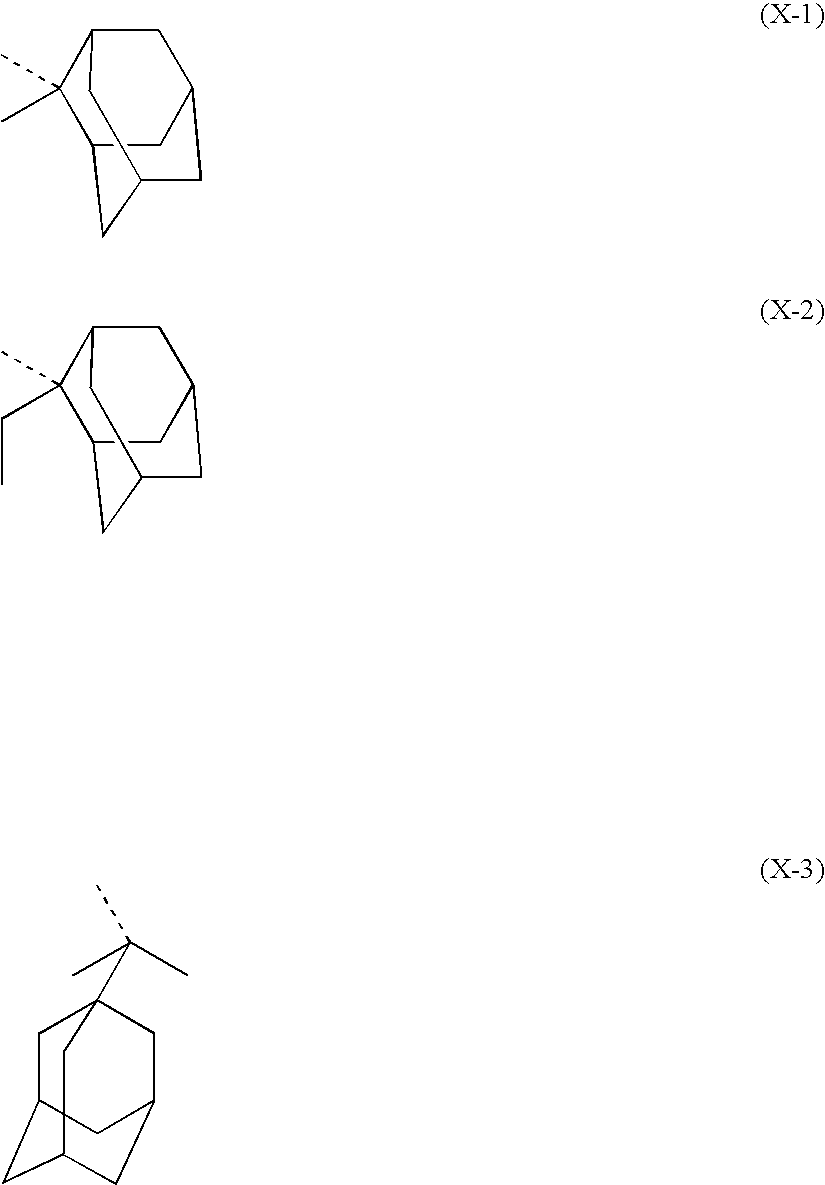Polymer, resist composition and patterning process
a technology of resist material and composition, applied in the field of polymer, resist composition and patterning process, can solve the problems of resist material having substantial line density dependency, inability to use resist material in an industrially acceptable manner, and inability to produce desired patterns in both dense and sparse regions at the same exposure, so as to improve resolution and proximity bias, the effect of minimizing absorption
- Summary
- Abstract
- Description
- Claims
- Application Information
AI Technical Summary
Benefits of technology
Problems solved by technology
Method used
Image
Examples
synthesis example 1
[0398] Synthesis of Polymer 1
[0399] There were combined 14.8 g of 2-ethyl-2-adamantyl methacrylate, 10.0 g of hydroxyadamantyl methacrylate, 15.2 g of 4,8-dioxatricyclo[4.2.1.03,7]nonan-5-on-2-yl methacrylate, and 120 g of 2-butanone. The mixture was heated at 80° C., after which 1.2 g of dimethyl 2,2′-azobisisobutyrate was added. The mixture was stirred for 10 hours while keeping at 80° C. The reaction mixture was cooled to room temperature and thereafter, added dropwise to 600 g of n-hexane, with vigorous stirring. Solids settled out and were separated by filtration and dried at 40° C. in vacuum for 15 hours. There was obtained a polymer in while powder solid form, designated Polymer 1. The amount was 32.4 g and the yield was 81%. The polymer had a weight average molecular weight (Mw) of 6,800 as measured by gel permeation chromatography (GPC) using polystyrene standards.
example 1
[0419] Using Polymer 1 obtained in Synthesis Example 1, a resist material was prepared according to the composition: [0420] (A) 80 parts by weight of Polymer 1 as the base resin, [0421] (B) 2.0 parts by weight of triphenylsulfonium nonafluorobutanesulfonate as the acid generator, [0422] (C) 640 parts by weight of propylene glycol monomethyl ether acetate as the solvent, and [0423] (D) 0.25 part by weight of triethanolamine as the organic nitrogen-containing compound.
This was passed through a Teflon® filter having a pore diameter of 0.2 μm.
[0424] The resist material was spin coated on a silicon wafer having an antireflection film (ARC29A by Nissan Chemical Co., Ltd., 78 nm) coated thereon and heat treated at 130° C. for 60 seconds, forming a resist film of 300 nm thick. The resist film was exposed to light in an ArF excimer laser stepper (Nikon Corp., NA=0.68), heat treated (PEB) at 120-130° C. for 60 seconds, cooled down to 23° C., and puddle developed in a 2.38% aqueous solution...
example 9
[0427] Using Polymer 9 obtained in Synthesis Example 9, a resist material was prepared according to the composition: [0428] (A) 80 parts by weight of Polymer 9 as the base resin, [0429] (B) 2.0 parts by weight of triphenylsulfonium nonafluorobutanesulfonate as the acid generator, [0430] (C) 640 parts by weight of propylene glycol monomethyl ether acetate as the solvent, and [0431] (D) 0.12 part by weight of triethanolamine as the organic nitrogen-containing compound.
This was passed through a Teflon® filter having a pore diameter of 0.2 μm.
[0432] The resist material was spin coated on a silicon wafer having an antireflection film (ARC29A by Nissan Chemical Co., Ltd., 78 nm) coated thereon and heat treated at 105° C. for 60 seconds, forming a resist film of 295 nm thick. The resist film was exposed to light in an ArF excimer laser stepper (Nikon Corp., NA=0.68), heat treated (PEB) at 120-130° C. for 60 seconds, cooled down to 23° C., and puddle developed in a 2.38% aqueous solution...
PUM
| Property | Measurement | Unit |
|---|---|---|
| size | aaaaa | aaaaa |
| thickness | aaaaa | aaaaa |
| wavelength | aaaaa | aaaaa |
Abstract
Description
Claims
Application Information
 Login to View More
Login to View More - R&D
- Intellectual Property
- Life Sciences
- Materials
- Tech Scout
- Unparalleled Data Quality
- Higher Quality Content
- 60% Fewer Hallucinations
Browse by: Latest US Patents, China's latest patents, Technical Efficacy Thesaurus, Application Domain, Technology Topic, Popular Technical Reports.
© 2025 PatSnap. All rights reserved.Legal|Privacy policy|Modern Slavery Act Transparency Statement|Sitemap|About US| Contact US: help@patsnap.com



